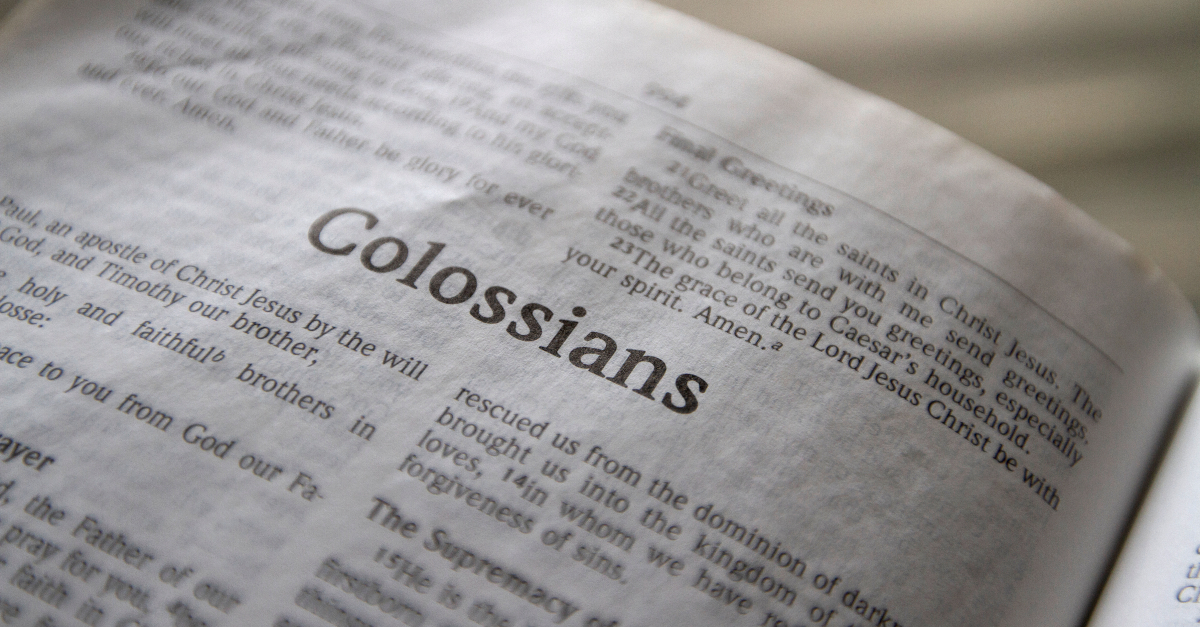The Book of Colossians is one of Paul’s prison epistles, written to the church at Colossae around A.D. 60–62. In this powerful letter, the Apostle Paul emphasizes the supremacy of Christ over all creation, the fullness of salvation through Him, and the call for believers to live transformed lives rooted in Christ’s lordship. Often referred to as a defense against heresy, Colossians reminds us that in Christ, we find complete reconciliation and maturity, countering philosophies that diminish His lordship. This book remains deeply relevant to Christians today, offering profound insights into faith, discipleship, church life, and spiritual growth.
Historical and Cultural Context of Colossians
To fully appreciate Colossians, we must understand its origins. Paul did not found the Colossian church; it was likely established by Epaphras, a co-worker of Paul, during Paul’s ministry in Ephesus (Acts 19), who reported to Paul about the congregation’s faith (Colossians 1:7-8). Though Paul had never visited Colossae, he wrote this letter to address troubling false teachings infiltrating the church. These teachings combined elements of Jewish legalism, Greek philosophy, and pagan mysticism, threatening to undermine the true gospel. This false teaching emphasized human wisdom, rituals like circumcision, and ascetic practices, while downplaying Christ’s full deity and humanity. Paul counters this by asserting Christ’s supremacy and sufficiency, warning against “hollow and deceptive philosophy” (Colossians 2:8).
Understanding the Book of 2 Corinthians: Ministry and Generosity
Paul wrote this letter around AD 58-62 during his imprisonment in Rome, likely alongside Ephesians and Philemon as part of the “prison epistles.” Addressed to the church in Colossae—a small city in Asia Minor (modern-day Turkey) known for its trade routes and diverse population—the epistle was delivered by Tychicus and Onesimus (Colossians 4:7-9). Colossae was near Laodicea and Hierapolis, forming a regional hub influenced by Greek philosophy, Jewish legalism, and mystery religions. Culturally, Colossae’s location exposed believers to syncretistic ideas, mirroring modern challenges like New Age spirituality or legalistic Christianity.
Thanksgiving, Prayer, and the Supremacy of Christ (Colossians 1)
Chapter 1 opens with Paul’s greeting as an apostle, partnering with Timothy (Colossians 1:1-2). He thanks God for the Colossians’ faith, love, and hope—fruits of the gospel spread by Epaphras (Colossians 1:3-8). Paul’s prayer: For spiritual wisdom, strength to endure, and gratitude for inheritance in light (Colossians 1:9-14).
The chapter’s pinnacle is the Christ hymn (Colossians 1:15-20), a majestic declaration of Christ’s supremacy: He is the “image of the invisible God, the firstborn over all creation” (verse 15). All things—visible and invisible, thrones and powers—were created through Him and for Him (verse 16). He holds all things together (verse 17), heads the church as the firstborn from the dead (verse 18), embodies God’s fullness (verse 19), and reconciles all through His blood (verse 20). This counters heresy by affirming Christ’s deity and role in creation and redemption.
Understanding the Book of 1 Corinthians: Church and Spirituality
Paul shares his ministry: Suffering for the church, revealing the mystery—Christ in you, the hope of glory (Colossians 1:21-29). For “Christ’s supremacy in Colossians 1,” this hymn is foundational, portraying Him as creator, sustainer, and reconciler. Practically, it inspires worship, grounding identity in His preeminence.
Warnings Against False Teachings (Colossians 2)
Paul expresses concern for the Colossians and Laodiceans, urging maturity in Christ (Colossians 2:1-5). He exhorts walking in Him, rooted and built up, abounding in thanksgiving (Colossians 2:6-7). Beware deceptive philosophy relying on human tradition, not Christ—in whom dwells God’s fullness bodily (Colossians 2:8-10).
Believers are complete in Christ: Circumcised spiritually, buried and raised in baptism (Colossians 2:11-12). God forgave sins, canceling the legal debt through the cross, triumphing over powers (Colossians 2:13-15). Thus, ignore judgments on food, festivals, or Sabbaths—these shadow Christ, the reality (Colossians 2:16-17). Avoid false humility, angel worship, or visions puffing up the mind (Colossians 2:18-19). Died with Christ to worldly principles? Don’t submit to ascetic rules—”Do not handle, taste, touch”—lacking value against indulgence (Colossians 2:20-23).
Understanding the Book of Galatians: Freedom and Faith
For “false teachings in Colossians,” this chapter dismantles legalism and mysticism, emphasizing Christ’s sufficiency.
Christian Living: New Life in Christ (Colossians 3)
Paul transitions from theology to practice, urging believers to put off the old self and embrace the new life in Christ (Colossians 3:1–10). He calls for holiness, forgiveness, compassion, and love within the community.
Set your minds on things above, where Christ is seated (Colossians 3:1-4). Put to death earthly nature: Sexual immorality, impurity, lust, evil desires, greed (idolatry), anger, malice, slander, filthy language (Colossians 3:5-9). Renewed in Creator’s image, where no distinctions—Greek/Jew, circumcised/uncircumcised, barbarian/Scythian, slave/free—but Christ is all in all (Colossians 3:10-11).
Clothe with compassion, kindness, humility, gentleness, patience; bear with, forgive as Lord forgave (Colossians 3:12-13). Above all, love binds in unity (Colossians 3:14). Christ’s peace rule hearts; be thankful (Colossians 3:15). Word dwell richly; teach, admonish with psalms, hymns, spiritual songs (Colossians 3:16). Do everything in Jesus’ name (Colossians 3:17).
Understanding the Book of Ephesians: Church and Unity
Household codes: Wives submit to husbands; husbands love wives (Colossians 3:18-19); children obey parents; parents do not embitter children (Colossians 3:20-21); slaves obey masters wholeheartedly, as for Lord; masters provide justly (Colossians 3:22-4:1). For “Christian conduct in Colossians,” this promotes heavenly focus, leading to holy living.
Final Exhortations and Greetings (Colossians 4)
Devote to prayer, watchful and thankful (Colossians 4:2). Pray for Paul’s ministry doors, proclaiming Christ’s mystery despite chains (Colossians 4:3-4). Act wisely toward outsiders; make most of opportunities; speech gracious, seasoned with salt (Colossians 4:5-6).
Greetings from companions: Tychicus delivers news; Onesimus, faithful brother; Aristarchus, fellow prisoner; Mark (reconciled); Jesus Justus; Epaphras, wrestling in prayer; Luke, doctor; Demas (Colossians 4:7-14). Exchange letters with Laodicea; Archippus fulfill ministry (Colossians 4:15-17). Paul’s handwritten greeting: Remember chains. Grace be with you (Colossians 4:18).
This relational close reinforces partnership, urging vigilance in faith.
Understanding the Book of Romans: Salvation and Faith
Structure of the Book of Colossians
The letter to the Colossians is short but dense, structured around theology and application:
- Introduction and Thanksgiving (Colossians 1:1–14) – Paul greets the church and prays for their growth in spiritual wisdom.
- Christ’s Supremacy (Colossians 1:15–23) – One of the most profound Christological passages in the New Testament.
- Paul’s Ministry and Suffering (Colossians 1:24–2:7) – Paul defends his ministry and encourages steadfastness in Christ.
- Warnings Against False Teaching (Colossians 2:8–23) – Paul addresses deceptive philosophies and traditions.
- New Life in Christ (Colossians 3:1–17) – A call to live out Christian virtues.
- Instructions for Households and Community (Colossians 3:18–4:6) – Guidance for families, work relationships, and prayer.
- Final Greetings (Colossians 4:7–18) – Paul concludes with personal notes and blessings.
Key Themes: Christ’s Supremacy and Sufficiency
The core theme of the book of Colossians is Christ’s supremacy: Preeminent in creation, redemption, and church (Colossians 1:15-20). He embodies God’s fullness, reconciles all (Colossians 2:9-10). This combats heresy, affirming His deity against diminishment.
Other themes: Sufficiency for salvation/sanctification—no additions needed; warnings against false philosophy; ethical transformation; unity in diversity (Colossians 3:11). Compared to Ephesians’ church focus, Colossians is more Christological. Recent discussions affirm its relevance: Shaping students with Christ’s supremacy. A new book explores this through commentary.
Christ’s Supremacy in Colossians
The Christ hymn in Colossians 1:15–20 is central to the book’s message. It presents Jesus as:
- The Image of the Invisible God – Revealing God to humanity.
- The Firstborn Over All Creation – Not created, but sovereign over creation.
- The Creator of All Things – By Him and for Him, everything exists.
- The Head of the Church – Giving life, direction, and authority.
- The Firstborn from the Dead – Guaranteeing resurrection and eternal life.
- The Fullness of God Dwelling in Him – Complete deity resides in Christ.
- The Reconciler of All Things – Making peace through His blood on the cross.
Application: This passage shows that Christ is supreme in creation, redemption, and the church. He is sufficient for salvation, spiritual growth, and eternal life.
Understanding the Book of Philippians: Joy and Partnership
Practical Lessons from Colossians
1. Christ Is Enough
Modern culture often pushes us to seek fulfillment in achievements, wealth, or self-improvement philosophies. Colossians reminds us that true completeness is found in Christ alone.
2. Live Out the New Life
Paul urges believers to “set your hearts on things above” (Colossians 3:1). Christians are called to live differently—showing love, kindness, and forgiveness in everyday relationships.
3. Guard Against False Doctrines
Just as the Colossians faced confusing teachings, today’s world offers distorted versions of Christianity. Colossians encourages believers to test everything against the truth of Christ.
4. The Church Must Stay Rooted in Christ
Colossians shows that a healthy church depends not on programs or traditions, but on Christ’s supremacy and the Spirit’s power.
5. Household and Work Relationships
Paul’s instructions to families and workers remain relevant today, reminding believers to glorify Christ in marriage, parenting, and professional life.
How Colossians Speaks to the Modern Church
In a world filled with competing ideologies, self-help spirituality, and pluralistic views, Colossians offers clarity and confidence. It shows that believers do not need to blend faith in Christ with other traditions to be “complete.”
Comparing Galatians and Romans: Freedom and Faith in Paul’s Epistles
The modern church, like Colossae, must stay centered on the gospel of Christ’s supremacy to avoid being swayed by secular philosophies or cultural pressures. Unity, maturity, and effective witness flow from a church rooted in Christ.
Conclusion
The Book of Colossians is a timeless reminder of the supremacy and sufficiency of Christ. Paul emphasizes that Jesus is above all rulers, traditions, and philosophies, and that in Him, believers are fully complete. The letter challenges us to resist false teachings, live out our new identity in Christ, and remain deeply rooted in Him.
As we embrace the message of Colossians, we are reminded that Christ is the foundation of our faith, the head of the church, and the One who sustains our lives. In Him, we find the fullness of God, the assurance of salvation, and the power to live transformed lives.
Understanding Romans 8: Life in the Spirit, Freedom, and God’s Unfailing Love
Frequently Asked Questions (FAQ)
- What is the main theme of Colossians? The supremacy and sufficiency of Christ over all creation and teachings.
- Who wrote Colossians and when? Paul, around AD 58-62 during Roman imprisonment.
- Why was Colossians written? To combat heresy denying Christ’s full deity and promote growth in Him.
- What is the Christ hymn in Colossians? Colossians 1:15-20, declaring His supremacy in creation and reconciliation.
- How is Colossians relevant today? It counters false philosophies, promotes ethical living, and affirms Christ’s lordship in diverse societies.
Recommended: Understanding The New Testament: Matthew To Revelation
Last modified: October 4, 2025





